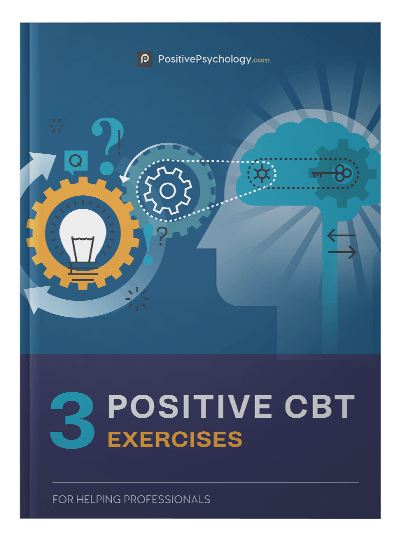Your Ultimate EMDR Guide (Incl. Techniques & Exercises)
 Eye movement desensitization and reprocessing (EMDR) is a short-term type of exposure therapy used primarily in the treatment of post-traumatic stress disorder (PTSD) and phobias.
Eye movement desensitization and reprocessing (EMDR) is a short-term type of exposure therapy used primarily in the treatment of post-traumatic stress disorder (PTSD) and phobias.
EMDR essentially rewires your brain to remove the negative emotional charge of a traumatic event so that you can remember the details of the event without feelings of distress.
In this article, we will explore EMDR therapy in depth. We will compare it with other therapies, check its efficacy, and look into training with a short list of useful apps for you to explore.
Before you read on, we thought you might like to download our three Positive Psychology Exercises for free. These science-based exercises explore fundamental aspects of positive psychology, including strengths, values, and self-compassion, and will give you the tools to enhance the wellbeing of your clients, students, or employees.
This Article Contains:
- What Is EMDR Therapy?
- How Does It Work?
- Is EMDR Effective? A Look at the Research
- Are There Dangers or Side Effects?
- Does It Work for Children?
- How to Do an EMDR Session + Process
- Training in EMDR Therapy
- EMDR vs. Hypnosis
- EMDR + Mindfulness
- 5 Apps and 2 Virtual EMDR Options
- A Note on Self-Administered EMDR
- A Take-Home Message
- References
What Is EMDR Therapy?
EMDR is a type of trauma therapy that was discovered by Francine Shapiro in the 1980s. Dr. Shapiro noticed that certain repetitive eye movements, when paired with distressing thoughts, would reduce the intensity of those thoughts.
She observed her behavior when thinking of upsetting thoughts, and she noticed that her eyes naturally began to move quickly back and forth. She hypothesized that when a person is faced with a traumatic situation, they may feel overwhelmed, and their normal coping mechanisms may not work.
When this happens, distressing thoughts and memories may be stored in the brain as a sensory memory rather than a factual memory. Since traumatic sensory memories may continue to overwhelm an individual, she suggested that EMDR therapy would help remove the emotionality associated with these memories, and the brain would be able to store the event in a more logical form.
By removing the feelings and sensations associated with the traumatic memory, the person would be able to recall the event alone without the distressing emotions. EMDR is often used in the treatment of post-traumatic stress disorder, trauma, or phobias.
How Does It Work?

Bilateral stimulation is paired with distressing memories to change beliefs about the event by alternately activating each half of the brain in order to create new neural connections (van den Hout & Engelhard, 2012).
Although EMDR originally began with eye movements, now several types of bilateral sensory input may be used (Parnell, 2013).
These may include asking a client to follow the practitioner’s moving finger with their eyes, a machine with lights that move back and forth, alternate taps to the client’s knees, or handheld vibrating pods that alternate the vibration and have adjustable speeds and intensities. The type of bilateral stimulation usually depends on the practitioner and client preference.
The adaptive processing model suggests that the body has a natural inclination to heal itself, like a wound forming a scab. However, traumatic memories may be stored in a raw sensory form in the limbic system, rather than as a semantic memory (Shapiro, 2002; van den Hout & Engelhard, 2012).
As long as the memory is stored in its raw form, the person will continue to feel distressed. When the sensory memory is paired with bilateral stimulation of the body, it lowers physiological arousal and allows the body to move the memory from an emotional form to a more logical form (van den Hout & Engelhard, 2012).
After EMDR treatment, a client should be able to remember the facts of a traumatic memory without feeling the previously associated distressing sensations, thoughts, or feelings.
Clients report starting a course with a low sense of self, due to feelings of hopelessness and a loss of control over the traumatic event. After EMDR therapy treatment, clients often report a greater sense of control and higher self-worth (Shapiro, 2002; Shapiro, 2007; van den Hout & Engelhard, 2012).
Is EMDR Effective? A Look at the Research
Since it is a relatively new treatment model, there is still some question as to the efficacy of EMDR.
Current research suggests that EMDR is as effective as some types of Exposure Therapy, as effective as Trauma-Focused Cognitive Behavioral Therapy, and more effective than selective serotonin re-uptake inhibitors alone (van der Kolk et al., 2007; Seidler & Wagner, 2006).
Currently, the International Society for Stress Studies, the U.S. Substance Abuse and Mental Health Services Administration, and the U.S. Departments of Veterans Affairs and Defense, all recommend EMDR for the treatment of PTSD.
Are There Dangers or Side Effects?

Potential side effects include vivid dreams or nightmares after a session, since the mind may continue processing the information during the REM stage of sleep (Parnell, 2013). Clients should be warned of the possibility of vivid dreams.
Other potential dangers include emotional distress during a session when the client is re-experiencing the traumatic event (Taylor et al., 2003).
Some emotional distress is expected in similar types of exposure therapy, and the distress is usually short lived. During an EMDR session, a client may feel temporarily worse, but a skilled practitioner will be able to use the installed safety protocols to avoid overwhelming distress in the client.
EMDR sessions tend to be twice as long as traditional therapy sessions so that a client has time to fully process a memory during one session (Shapiro, 2002). A client should leave each session feeling more empowered and calmer than they initially felt.
Does It Work for Children?
EMDR works very well for children, with some adaptation.
Clinicians must explain the process in a developmentally appropriate way. However, since EMDR is a sensory-based therapy, it can be used even with nonverbal children or those diagnosed with autism spectrum disorders (Gomez, 2012; Shapiro, 2007).
Clinicians who are interested in EMDR for children should consider reading EMDR Therapy and Adjunct Approaches with Children: Complex Trauma, Attachment, and Dissociation by Dr. Ana Gomez (2012).
How to Do an EMDR Session + Process

Sessions often last 90 minutes, rather than the traditional 45-minute psychotherapy session. Some clients may feel relief in as few as six EMDR sessions (Shapiro, 2007).
The treatment model includes client history taking, client preparation, assessment, desensitization, body scan, closure, and re-evaluation of the treatment (Shapiro, 2002; Shapiro, 2007). During the client preparation phase, the clinician will be sure to address the EMDR safety protocols by establishing images or memories that the client may return to whenever the trauma therapy becomes overwhelming (Parnell, 2013).
Phase one
The first phase is taking a client’s history and planning the course of treatment (Shapiro, 2002; Shapiro, 2007; Parnell, 2013). The clinician is looking for a suitable target to begin the EMDR therapy and any background information that may be causing the maladaptive behavior to continue (secondary gains).
The clinician will want to identify the most distressing memory and target that first, whether it’s an early childhood memory or a current trauma. EMDR works as sequential processing, so when the correct target is processed, subsequent stressors will also be addressed.
Phase two
The second phase is about client preparation (Shapiro, 2002; Shapiro, 2007; Parnell, 2013). Since EMDR is a type of trauma therapy, the therapeutic alliance between the clinician and client is crucial. This is the phase when the clinician will engage the client in the therapeutic process and establish a rapport.
During this phase, the therapist explains the EMDR process to the client and will teach techniques to close an incomplete session.
Phase three
The third phase is the assessment phase, when the therapist and client decide together which will be the first memory that is targeted (Shapiro, 2002; Shapiro, 2007; Parnell, 2013). This is often the most distressing memory but during a discussion of the trauma, they may find that an earlier childhood memory is the root cause of the distress, in which case that memory would be targeted instead.
The client will identify the most distressing image of the traumatic event (like a photograph) and the negative beliefs associated with that memory. Positive beliefs, as a goal, may also be included in this phase. The client and therapist will discuss the validity of cognitions (VOC), which identifies how realistic their negative beliefs really are.
Often the VOC is skipped when working with children, since they may have a difficult time with this abstract concept (Gomez, 2012; Parnell, 2013). They will also identify the subjective units of disturbance (SUD), which is a subjective measurement of how distressing the memory is.
The SUD will be measured again later in the process, and this is how the therapist will be able to identify how the client is progressing in treatment. Safety protocols (identifying a safe place, wise person, etc.) that the client can later mentally call up during the fourth phase are discussed in this phase.
Phase four
The fourth phase is the desensitization phase, when the client is asked to pair the distressing memory with therapist-directed bilateral stimulation (Shapiro, 2002; Shapiro, 2007; Parnell, 2013).
This is to change the traumatic event from a sensory experience to a purely factual experience so that the emotionality of the event is removed and the client can remember the facts without feeling overwhelmed by their feelings.
Self-efficacy, a sense of control, and empowerment are also addressed in this phase. The therapist must make sure that the client stays within the locus of control while challenging their beliefs.
This is when the safety protocols may come into play; if the client starts feeling distressed by their memories, they can “bring in” a wise person, spirit animal, or another avatar to help soothe them and help them safely navigate their memory.
Phase five
The fifth phase is the installation phase, when the VOC is again addressed, to replace negative self-beliefs with more positive ones (Shapiro, 2002; Shapiro, 2007).
Phase six
The sixth phase is the body scan, when the client is asked to recall the original distressing image and to see if there is still any sensory memory associated with the image (Shapiro, 2002; Shapiro, 2007; Parnell, 2013).
If there are still body sensations associated with the memory, any somatic memories, the target image has not been fully processed yet. The client and therapist will identify if the memory simply needs more processing or if there is another target memory that is more salient and needs to be addressed first.
Phase seven
The seventh is the closure phase. This phase is when self-control techniques that were learned in an earlier session are reviewed and reinstalled (Shapiro, 2002; Shapiro, 2007; Parnell, 2013). The purpose is to return the client from a state of unrest to a state of equilibrium.
Self-soothing and calming techniques are reviewed during this phase, in case the client has any unprocessed feelings or to help when new stressors emerge. The client is asked to keep a record of any disturbances, dreams, uncomfortable body sensations, thoughts, or feelings to address in a future session.
Phase eight
The eighth and final phase is the re-evaluation phase, when the client and therapist review which aspects of the treatment are helping the most and identify other targets that may need to be addressed (Shapiro, 2002; Shapiro, 2007; Parnell, 2013).
Training in EMDR Therapy
EMDR certification requires having an advanced mental health license, taking several theory classes, and direct application of EMDR and multiple sessions with an EMDR supervisor.
The EMDR International Association certifies practitioners in the model. Although there is one primary certifying body, there are a couple of schools, such as the Parnell Institute, that provide EMDR training to prepare clinicians for certification.
EMDR vs. Hypnosis
EMDR is very similar to hypnosis in many ways (Harford, 2010).
In EMDR, the client is asked to go into a relaxing, trance-like state to mindfully recall the sensory information that they gathered during a traumatic event. The trance is an integral part of EMDR because without it, the client will feel a heightened emotional response, over-activate the limbic system, and will not be able to process the disturbing memory adaptively.
It is the practitioner’s job to keep the client in a semi-hypnotic state that allows the client to recall the distressing event while maintaining a sense of control over the situation (Parnell, 2013).
The hypnotic suggestion that the client may use safety protocols to better understand the facts of the situation (rather than seeing them even through a purely emotional lens) is what allows the client to maintain a sense of calm and control throughout the session (Harford, 2010).
This helps the clinician maintain a goal and directive for the session and help guide the client through their healing process. Like hypnotherapy, the clinician does not need to hear or know all the facts of the traumatic event, as long as the client is aware of the sensations, feelings, and thoughts involved in the event.
EMDR + Mindfulness

A typical EMDR session will have the client recalling mindful images of traumatic events, including smells, sights, tastes, and odors.
Clients who already have practice with mindfulness may be more comfortable doing EMDR since they already are more in tune with their surroundings (Sun & Chiu, 2006). Although EMDR does not typically have homework, it may benefit clients to practice mindfulness meditation throughout the day.
Even though EMDR asks clients to focus on being mindful, EMDR tends to be more goal oriented than self-practiced mindfulness.
5 Apps and 2 Virtual EMDR Options
Several apps use EMDR-type techniques to help treat anxiety. These should be used as a supplement to regular EMDR treatment or to treat lesser phobias and stressors. A certified EMDR practitioner should treat complex trauma, phobias, and PTSD.
1. Anxiety Release Based on EMDR

This app focuses on relieving anxiety through bilateral stimulation. Features include guided instructions and a brain training session. It can be used by clients and
clinicians.
2. EyeMove EMDR Therapy

This app lets you choose an object to observe and alter the color, speed, and size to suit your needs.
3. EMDR Therapy

It utilizes both images and sounds to integrate bilateral stimulation into your session. It has features suited for both children and adults.
4. Virtual EMDR

It is an audio-only meditation tool that uses bilateral auditory stimulation to help people find release from overwhelming stressors.
5. EMDR 101

It provides guided EMDR sessions in combination with bilateral visual stimulation to help people work through difficult issues. It can be used by a client alone or a client and clinician together.
6. remotEMDR

7. EMDRremote.com
EMDRremote.com is an online site that allows a clinician to control a light-bar via the internet to provide EMDR services remotely.
A Note on Self-Administered EMDR
Any type of bilateral stimulation can be helpful in the processing of traumatic or stressful memories. Self-administered EMDR can include walking, jogging, drum circles, tapping (bilaterally), and even horseback riding.
Anything that has a rhythmic activation of alternating sides of the body may be used for self-administered EMDR (Parnell, 2008).
Again, complex traumas, severe phobias, and PTSD should be treated by a certified professional. But anyone who experiences minor stressors, anxiety, or traumas may feel relief when pairing bilateral stimulation while focusing on that stressor.
The person may feel a sense of clarity or relief as a result of combining the distressing thoughts with movements (Parnell, 2008).
A Take-Home Message
We all naturally participate in some form of bilateral stimulation daily (walking, swimming, dancing).
EMDR utilizes our natural biological healing to help us process unwanted, disturbing thoughts, feelings, and memories (Parnell, 2008).
Although minor stressors can be self-treated, severe traumas, phobias, and PTSD should be addressed by a certified clinician.
EMDR is a fast-paced therapy, and clients may find relief in as few as six sessions. Although research is ongoing, many studies find that EMDR is an effective form of exposure therapy (Seidler & Wagner, 2006).
We hope you enjoyed reading this article. Don’t forget to download our three Positive Psychology Exercises for free.
- Gomez, A. M. (2012). EMDR therapy and adjunct approaches with children: Complex trauma, attachment, and dissociation. Springer Publishing Company.
- Harford, P. M. (2010). The integrative use of EMDR and clinical hypnosis in the treatment of adults abused as children. Journal of EMDR Practice and Research, 4(2), 60–75.
- Parnell, L. (2008). Tapping in: A step-by-step guide to activating your healing resources through bilateral stimulation. Sounds True.
- Parnell, L. (2013). Attachment-focused EMDR: Healing relational trauma. W.W. Norton & Company.
- Seidler, G. H., & Wagner, F. E. (2006). Comparing the efficacy of EMDR and trauma-focused cognitive-behavioral therapy in the treatment of PTSD: A meta-analytic study. Psychological Medicine, 36(11), 1515–1522.
- Shapiro, F. E. (2002). EMDR as an integrative psychotherapy approach: Experts of diverse orientations explore the paradigm prism. American Psychological Association.
- Shapiro, F. (2007). Handbook of EMDR and family therapy processes. John Wiley & Sons.
- Sun, T. F., & Chiu, N. (2006). Synergism between mindfulness meditation training, and eye movement desensitization and reprocessing in psychotherapy of social phobia. Chang Gung Medical Journal, 29(4), 1–4.
- Taylor, S., Thordarson, D. S., Maxfield, L., Fedoroff, I. C., Lovell, K., & Ogrodniczuk, J. (2003). Comparative efficacy, speed, and adverse effects of three PTSD treatments: Exposure therapy, EMDR, and relaxation training. Journal of Consulting and Clinical Psychology, 71(2), 330–338.
- van der Kolk, B. A., Spinazzola, J., Blaustein, M. E., Hopper, J. W., Hopper, E. K., Korn, D. L., & Simpson, W. B. (2007). A randomized clinical trial of eye movement desensitization and reprocessing (EMDR), fluoxetine, and pill placebo in the treatment of posttraumatic stress disorder: Treatment effects and long-term maintenance. Journal of Clinical Psychiatry, 68(1), 37–46.
- van den Hout, M. A., & Engelhard, I. M. (2012). How does EMDR work? Journal of Experimental Psychopathology, 3(5), 724–738.
Read other articles by their category
- Body & Brain (41)
- Coaching & Application (49)
- Compassion (27)
- Counseling (46)
- Emotional Intelligence (23)
- Gratitude (16)
- Grief & Bereavement (19)
- Happiness & SWB (35)
- Meaning & Values (26)
- Meditation (21)
- Mindfulness (42)
- Motivation & Goals (42)
- Optimism & Mindset (33)
- Positive CBT (24)
- Positive Communication (21)
- Positive Education (41)
- Positive Emotions (28)
- Positive Psychology (33)
- Positive Workplace (38)
- Relationships (31)
- Resilience & Coping (33)
- Self Awareness (21)
- Self Esteem (38)
- Software & Apps (23)
- Strengths & Virtues (28)
- Stress & Burnout Prevention (27)
- Theory & Books (42)
- Therapy Exercises (30)
- Types of Therapy (53)



